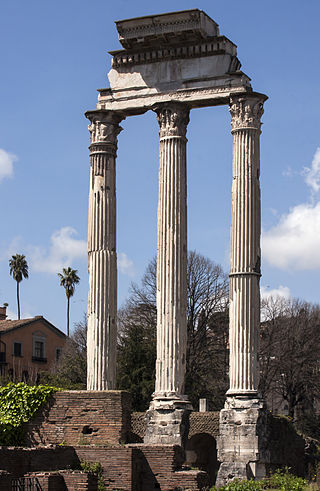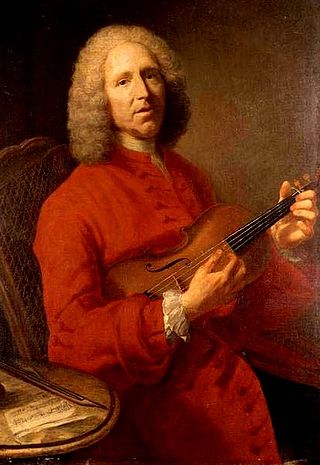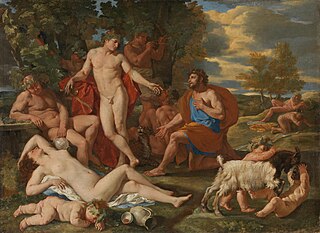Description
The painting depicts the mortal Castor and the immortal Pollux abducting Phoebe and Hilaeira, daughters of Leucippus of Messenia. Castor the horse-tamer is recognisable from his armour, whilst Pollux the boxer is shown with a bare and free upper body. They are also distinguished by their horses—Castor's is well-behaved and supported by a putto, whereas Pollux's is rearing. The putto's black wing shows the twins' ultimate fate.
In the painting, Phoebe and Hilaeira do not have distinguishing attributes. From the literature on Greek myths, however, we learn that Phoebe bore a son, Mnesleos, to Pollux, and Hilaeira bore a son, Anogon, to Castor. It would seem therefore, from the directions of the twins' fixed and admiring stares, that the daughter in the lower position, with her back to us, is Phoebe, and the daughter in the upper position, displaying a frontal view, is Hilaeira.

Castor and Pollux are twin half-brothers in Greek and Roman mythology, known together as the Dioscuri or Dioskouroi.

In Greek mythology, Hilaera was a Messenian princess.

In Greek mythology, Idas, was a Messenian prince. He was one of the Argonauts, a participant in the hunt for the Calydonian Boar and contender with the gods. Idas was described as keen and spirited.

The Alte Pinakothek is an art museum located in the Kunstareal area in Munich, Germany. It is one of the oldest galleries in the world and houses a significant collection of Old Master paintings. The name Alte (Old) Pinakothek refers to the time period covered by the collection—from the fourteenth to the eighteenth century. The Neue Pinakothek, re-built in 1981, covers nineteenth-century art, and Pinakothek der Moderne, opened in 2002, exhibits modern art. All three galleries are part of the Bavarian State Painting Collections, an organization of the Free state of Bavaria.

The Temple of Castor and Pollux is an ancient temple in the Roman Forum, Rome, Central Italy. It was originally built in gratitude for victory at the Battle of Lake Regillus. Castor and Pollux were the Dioscuri, the "twins" of Gemini, the twin sons of Zeus (Jupiter) and Leda. Their cult came to Rome from Greece via Magna Graecia and the Greek culture of Southern Italy.

Adam Elsheimer was a German artist working in Rome, who died at only thirty-two, but was very influential in the early 17th century in the field of Baroque paintings. His relatively few paintings were small-scale, nearly all painted on copper plates, of the type often known as cabinet paintings. They include a variety of light effects, and an innovative treatment of landscape. He was an influence on many other artists, including Rembrandt and Peter Paul Rubens.

The Neue Pinakothek is an art museum in Munich, Germany. Its focus is European Art of the 18th and 19th centuries, and it is one of the most important museums of art of the nineteenth century in the world.

Leo von Klenze was a German architect and painter. He was the court architect of Ludwig I of Bavaria.
In Greek mythology, Lynceus was a Messenian prince and one of the Argonauts who served as a lookout on the Argo. He also participated in the hunt for the Calydonian boar.

Castor et Pollux is an opera by Jean-Philippe Rameau, first performed on 24 October 1737 by the Académie royale de musique at its theatre in the Palais-Royal in Paris. The librettist was Pierre-Joseph-Justin Bernard, whose reputation as a salon poet it made. This was the third opera by Rameau and his second in the form of the tragédie en musique. Rameau made substantial cuts, alterations and added new material to the opera for its revival in 1754. Experts still dispute which of the two versions is superior. Whatever the case, Castor et Pollux has always been regarded as one of Rameau's finest works.

In Greek mythology, Phoebe was a Messenian princess.

The Bavarian State Painting Collections, based in Munich, Germany, oversees artwork held by the Free State of Bavaria. It was established in 1799 as Centralgemäldegaleriedirektion. Artwork includes paintings, sculptures, photographs, video art and installation art. Pieces are on display in numerous galleries and museums throughout Bavaria.

Jan Wildens was a Flemish painter and draughtsman specializing in landscapes. His Realist landscapes show an eye for detail and have a serene character. He was a regular collaborator with Rubens and other leading Flemish Baroque painters of his generation in whose compositions he painted the landscapes.

Johannes Hubertus Leonardus de Haas was a Dutch animal and landscape painter, and a peripheral figure of the Hague School.

The Hippopotamus and Crocodile Hunt is an oil painting on canvas by Peter Paul Rubens. It was commissioned in 1615 to decorate Schleißheim Palace, along with three other works depicting lion, wolf, and boar hunts. The cycle of paintings was looted from the palace during the Napoleonic Wars. Only the Hippopotamus and Crocodile Hunt was returned to Munich, at which time it was added to the collection that is now the Alte Pinakothek.

The Paumgartner altarpiece is an early triptych painting by Albrecht Dürer, commissioned by the Paumgartner family of Nuremberg. The central panel depicts a nativity scene, while the wings depict Saint George (left) and Saint Eustace (right). The saint's faces are donor portraits of the brothers Stephan and Lukas Paumgartner, respectively. Other members of the Paumgartner family are depicted as small figures in the center panel.
The Anakeion or Anacaeum, also known as the Sanctuary of the Dioskouroi, was a temple in Athens, which was situated near the Acropolis and dedicated to Castor and Pollux.

The Underworld Painter was an ancient Greek Apulian vase painter whose works date to the second half of the 4th century BC.
In Greek mythology, Phoebe was the name or epithet of the following characters:

Midas and Bacchus is an oil painting usually attributed to Nicolas Poussin and dated to about 1624–1629, which is now in the Alte Pinakothek, Munich.
















